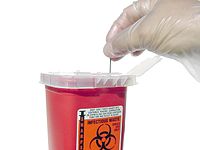Biological hazard: Difference between revisions
No edit summary |
spelling correction |
||
| Line 6: | Line 6: | ||
'''Biological hazards''', also known as '''biohazards''', refer to [[biological]] substances that pose a threat to the health of living organisms, primarily that of humans. This can include medical waste or samples of a [[microorganism]], [[virus]] or [[toxin]] (from a biological source) that can impact human health. It can also include substances harmful to animals. The term and [[Biohazard sign#Biohazard sign|its associated symbol]] is generally used as a warning, so that those potentially exposed to the substances will know to take precautions. |
'''Biological hazards''', also known as '''biohazards''', refer to [[biological]] substances that pose a threat to the health of living organisms, primarily that of humans. This can include medical waste or samples of a [[microorganism]], [[virus]] or [[toxin]] (from a biological source) that can impact human health. It can also include substances harmful to animals. The term and [[Biohazard sign#Biohazard sign|its associated symbol]] is generally used as a warning, so that those potentially exposed to the substances will know to take precautions. |
||
For instance recently a woman from Modesto California was hit on her face by fluids stemming from the liquifing body of a neighbour of hers.The fluids seeped through the ceiling of her |
For instance recently a woman from Modesto California was hit on her face by fluids stemming from the liquifing body of a neighbour of hers.The fluids seeped through the ceiling of her apartment. |
||
http://languish.org/forums/index.php?topic=701.0 |
http://languish.org/forums/index.php?topic=701.0 |
||
http://cbs2.com/watercooler/Decomposing.Corpse.Fluids.2.1015167.html |
http://cbs2.com/watercooler/Decomposing.Corpse.Fluids.2.1015167.html |
||
Revision as of 23:16, 26 May 2010

This article needs attention from an expert on the subject. Please add a reason or a talk parameter to this template to explain the issue with the article. (April 2010) |
Biological hazards, also known as biohazards, refer to biological substances that pose a threat to the health of living organisms, primarily that of humans. This can include medical waste or samples of a microorganism, virus or toxin (from a biological source) that can impact human health. It can also include substances harmful to animals. The term and its associated symbol is generally used as a warning, so that those potentially exposed to the substances will know to take precautions. For instance recently a woman from Modesto California was hit on her face by fluids stemming from the liquifing body of a neighbour of hers.The fluids seeped through the ceiling of her apartment. http://languish.org/forums/index.php?topic=701.0 http://cbs2.com/watercooler/Decomposing.Corpse.Fluids.2.1015167.html
In Unicode, the biohazard sign is U+2623 (☣).
Biohazardous agents are classified for transportation by UN number:
(Based on earlier edits)
- UN 2814 (Infectous substance to Humans)
- UN 2900 (Infectous substance to Animals)
- UN 3291 (Medical Waste)
(From http://www.ocio.usda.gov/directives/doc/DR9630-001.htm)
- Category A, UN 2814- Infectious substances affecting humans and animals: An infectious substance in a form capable of causing permanent disability or life-threatening or fatal disease in otherwise healthy humans or animals when exposure to it occurs.
- Category B, UN 2900- Infectious substances affecting animals only: An infectious substance that is not in a form generally capable of causing permanent disability of life-threatening or fatal disease in otherwise healthy humans and animals when exposure to it occurs.
- Category B, UN 3373- Biological substance transported for diagnostic or investigative purposes.
- Regulated Medical Waste, UN 3291- Waste or reusable material derived from medical treatment of an animal or human, or from biomedical research, which includes the production and testing of biological products.
Levels of biohazard

The United States' Centers for Disease Control and Prevention (CDC) categorizes various diseases in levels of biohazard, Level 1 being minimum risk and Level 4 being extreme risk.
- Biohazard Level 1: Bacteria and viruses including Bacillus subtilis, canine hepatitis, Escherichia coli, varicella (chicken pox), as well as some cell cultures and non-infectious bacteria. At this level precautions against the biohazardous materials in question are minimal, most likely involving gloves and some sort of facial protection. Usually, contaminated materials are left in open (but separately indicated) waste receptacles. Decontamination procedures for this level are similar in most respects to modern precautions against everyday viruses (i.e.: washing one's hands with anti-bacterial soap, washing all exposed surfaces of the lab with disinfectants, etc). In a lab environment, all materials used for cell and/or bacteria cultures are decontaminated via autoclave.
- Biohazard Level 2: Bacteria and viruses that cause only mild disease to humans, or are difficult to contract via aerosol in a lab setting, such as hepatitis A, B, and C, influenza A, Lyme disease, salmonella, mumps, measles, scrapie, dengue fever, and HIV. "Routine diagnostic work with clinical specimens can be done safely at Biosafety Level 2, using Biosafety Level 2 practices and procedures. Research work (including co-cultivation, virus replication studies, or manipulations involving concentrated virus) can be done in a BSL-2 facility, using BSL-3 practices and procedures. Virus production activities, including virus concentrations, require a BSL-3 facility and use of BSL-3 practices and procedures", see Recommended Biosafety Levels for Infectious Agents[1].
- Biohazard Level 3: Bacteria and viruses that can cause severe to fatal disease in humans, but for which vaccines or other treatments exist, such as anthrax, West Nile virus, Venezuelan equine encephalitis, SARS virus, variola virus (smallpox), tuberculosis, typhus, Rift Valley fever, Rocky Mountain spotted fever, yellow fever, and malaria. Among parasites Plasmodium falciparum, which causes Malaria, and Trypanosoma cruzi, which causes trypanosomiasis, also come under this level.
- Biohazard Level 4: Viruses and bacteria that cause severe to fatal disease in humans, and for which vaccines or other treatments are not available, such as Bolivian and Argentine hemorrhagic fevers, H5N1(bird flu), Dengue hemorrhagic fever, Marburg virus, Ebola virus, hantaviruses, Lassa fever, Crimean-Congo hemorrhagic fever, and other hemorrhagic diseases. When dealing with biological hazards at this level the use of a Hazmat suit and a self-contained oxygen supply is mandatory. The entrance and exit of a Level Four biolab will contain multiple showers, a vacuum room, an ultraviolet light room, autonomous detection system, and other safety precautions designed to destroy all traces of the biohazard. Multiple airlocks are employed and are electronically secured to prevent both doors opening at the same time. All air and water service going to and coming from a Biosafety Level 4 lab will undergo similar decontamination procedures to eliminate the possibility of an accidental release.
See also
References
Notes
Bibliography
- Baldwin, C. L., & Runkle, R.S. (1967). Biohazards symbol: development of a biological hazards warning signal. Science, 158, 264–265. Pubmed unique identifier 6053882.
- Preston, Richard. (1994). The Hot Zone. Anchor Books: Division of Random House; New York.
- Preston, Richard. (2002). The Demon in the Freezer: A True Story. of Random House; New York.
External links
- "Biosafety in Microbiological and Biomedical Laboratories", official CDC guide.
- "Prevention of Biological Hazards", EU-OSHA
- "Symbol Making", an account of the development of the symbol.
